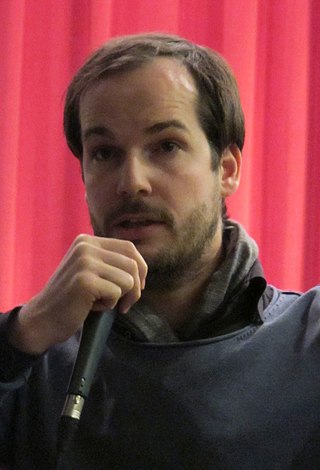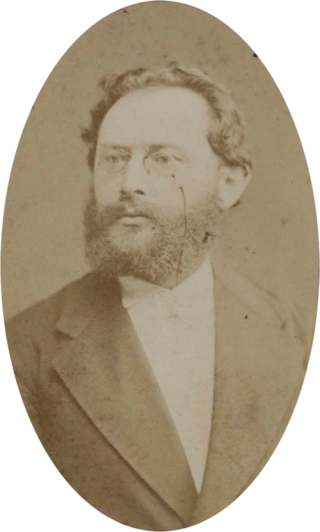
Max Liebermann was a German painter and printmaker, and one of the leading proponents of Impressionism in Germany and continental Europe. In addition to his activity as an artist, he also assembled an important collection of French Impressionist works.

Emil Schürer was a German Protestant theologian known mainly for his study of the history of the Jews around the time of Jesus' ministry.

The Berlin Secession was an art movement established in Germany on May 2, 1898. Formed in reaction to the Association of Berlin Artists, and the restrictions on contemporary art imposed by Kaiser Wilhelm II, 65 artists "seceded," demonstrating against the standards of academic or government-endorsed art. The movement is classified as a form of German Modernism, and came on the heels of several other secessions in Germany, including Jugendstil and the Munich Secession.

Meyer Kayserling was a German rabbi and historian.
Walter Grundmann was a German Protestant theologian and antisemitic Nazi and Stasi collaborateur during the Third Reich and GDR. Grundmann served both German dictatorships. He was a member of the Nazi party from 1930 onwards, and from 1933 onwards an active member of the German Christians and prospered as a state-antisemitism supporting theologian and professor for ethnic theology. In 1939, he was made head of the newly founded Instituts zur Erforschung jüdischen Einflusses auf das deutsche kirchliche Leben in Jena, which was meant to serve state antisemitism by the "Entjudung" (dejudifying) of the Bible and giving antisemitic theological training and arguments for Nazi propaganda. Despite his past Nazi activities, Grundmann regained some prestige as an evangelic theologian in East Germany; in 1959 he published his comments on the Gospels, which by the 1980s had become standard popular literature. However, Grundmann also prospered as a "Secret Informer" to the Ministry for State Security ("Stasi"). He spied on theologians in Eastern and Western Germany. His cover name was GM Berg after the Sermon on the Mount ("Bergrede") to which he referred in his inaugural speech 1939 at the Institute for the Study and Elimination of Jewish Influence on German Church Life, set up under him in Jena.

The Institute for the Study and Elimination of Jewish Influence on German Church Life was a cross-church establishment by eleven German Protestant churches in Nazi Germany, founded at the instigation of the German Christian movement. It was set up in Eisenach under Siegfried Leffler and Walter Grundmann. Georg Bertram, professor of New Testament at the University of Giessen, who led the Institute from 1943 until the Institute's dissolution in May 1945, wrote about its goals in March 1944: "'This war is Jewry's war against Europe.' This sentence contains a truth which is again and again confirmed by the research of the Institute. This research work is not only adjusted to the frontal attack, but also to the strengthening of the inner front for attack and defence against all the covert Jewry and Jewish being, which has oozed into the Occidental Culture in the course of centuries, ... thus the Institute, in addition to the study and elimination of the Jewish influence, also has the positive task of understanding the own Christian German being and the organisation of a pious German life based on this knowledge."

The Hamburg Temple is a former Reform Jewish congregation and synagogue, located in Hamburg, Germany. The congregation was the first permanent Reform Jewish community and the first to have a Reform prayer rite. It operated from 1818 to 1938. On 18 October 1818 the Temple was inaugurated and later twice moved to new edifices, in 1844 and 1931, respectively. The congregation abandoned the synagogue in 1938.

Samuel Lublinski was a Berlin-based writer, literary historian, critic, and philosopher of religion. He was a pioneer of the socio-historical study of literary movements and a major contributor to the debates about German-Jewish national and cultural identity of the era.

Max Czollek is a German writer, lyric-poet, stage performer and curator. He is a member of the "G13" authors' collective.

Sinai Simon Naschér was a Hungarian Jewish religious leader and writer.
Manfred Lewandowski was a German-American cantor, classical baritone and composer.

Lempertz is a German auction house which emerged from a bookstore and art gallery founded 1845 in Bonn, Germany. It is entirely owned and controlled by the Lempertz family and headquartered in Cologne, Germany.

Leo Lewin was a German merchant, art collector and horse breeder who was persecuted by the Nazis due to being Jewish.
Kathrin Hoffmann-Curtius was a German, independent art historian, who taught for a time at the universities of Tübingen, Hamburg, Trier and Vienna.

Milgroim. Journal for Art and Literature was a Yiddish cultural magazine that was published between 1922 and 1924 in Berlin by Rimon. At the same time, the Hebrew language magazine Rimon was published in a similar format. Milgroym and rimon means "pomegranate" in Yiddish and Hebrew, respectively.

Margarete Oppenheim was a German art collector and patron. She was among the first personalities to collect works of modern art in Germany and owned one of the largest collection in Germany. She is also known as Margarete Oppenheim-Reichenheim.
The art collection of Carl Sachs, a Jewish entrepreneur who lived with his wife Margarethe in a villa in what was then Kleinburgstraße in Breslau, before 1939 he emigrated to Switzerland with his wife to escape Nazi persecution, included numerous paintings, watercolors and graphics.

Leo Smoschewer was a German Jewish mechanical engineering entrepreneur and art collector whose business was Aryanized and art collection seized by the Nazis.

Portrait of the Painter Lovis Corinth is an oil-on-canvas painting by the German painter Max Liebermann, created in 1899. It depicts fellow German painter Lovis Corinth in a half-length portrait. The painting is in the possession of the Deutsche Bank, in Frankfurt.

Butcher Store in Schäftlarn on the Isar is a painting by the German painter Lovis Corinth from 1897. The picture shows a scene from the store of a slaughterhouse in Schäftlarn near Munich. It is held in the Kunsthalle Bremen.
















